ACG Advisory Board Members Choose Favorite War Photos
The January 2010 issue of Armchair General magazine features the cover story “War: A Photo Essay,” our picks for 25 of history’s greatest war photos (plus 5 Great Photos we didn’t pick and 6 Famous Fakes). We asked our ACG Advisory Board members to select their own favorite war images. Their choices appear below.
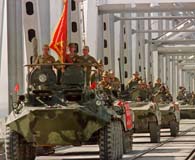 Gen. Hal Moore – Soviets Leave Afghanistan 1989
Gen. Hal Moore – Soviets Leave Afghanistan 1989
“On February 16, 1989, the Soviets pulled out of Afghanistan. They crossed the Friendship Bridge, led by Lt. Gen. Boris V. Gromov (last Russian off the Afghan land). They had been in Afghan nine years and 50 days. I and several other Vietnam Vets went to the Soviet Union and met, and hiked with former Russian soldiers who were Vets from the Afghan war. We met in Moscow and then trecked together. We spent time in advance of the trip learning their language somewhat. We developed a common bond — we were both evacuated and lost both wars.
Photos of the Russian pullout have always been important to me. Perhaps it is because it serves as a reminder of the Vietnam War and what may lie ahead for us in Afghanistan.”
{default}–Gen. Hal Moore
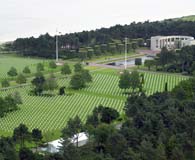 Carlo D’Este – Photo of U.S. cemetery at Normandy
Carlo D’Este – Photo of U.S. cemetery at Normandy
“Since the founding of our nation the price of freedom has always come at a high cost. It is one of our government’s solemn responsibilities to honor the fallen, many of whom are buried overseas in military cemeteries like this one at St.-Laurent-sur-Mer, Normandy, France. That duty is superbly carried out with great care and dignity by the American Battle Monuments Commission.”
–Carlo D’Este
 Jack Mountcastle – Chosin Marine, Korean War 1950
Jack Mountcastle – Chosin Marine, Korean War 1950
“I have chosen this photo by David Douglas Duncan. It was originally published by Life magazine in 1951. Later, it was featured in Duncan’s excellent pictorial presentation entitled This is War!: a Photo-narrative of the Korean War.
Duncan accompanied Marines of the 1st Marine Division who were ‘attacking in a different direction’ from the Chosin Reservoir during the seventeen-day period between November 27 and December 13, 1950.
The young Marine’s bone-deep fatigue is evident. But so is his determination to carry on, in spite of the brutal cold and overwhelming numbers of Chinese that assaulted the American Marines, British Marines, and American Soldiers who fought their way to the coast of North Korea. These fighting men knew that U.S. Navy ships were waiting for them at the port of Hungnam.
This young man has been, for me, the quintessential warrior — ever since I first saw this photo taken by Duncan, a former Marine and masterful Life Magazine war photographer.”
–BG ret. Jack Mountcastle
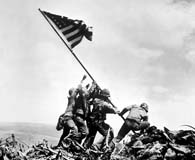 Ralph Peters – Iwo Jima flag raising photo
Ralph Peters – Iwo Jima flag raising photo
"Without question, the greatest war photo — to me — is the shot of U.S.
Marines raising our flag on Mt. Suribachi on Iwo Jima. I don’t care about the claims that it was posed. Heroism will always have its detractors. It’s a magnificent photo that captures American fighting men at the moment of a hard-won triumph for civilization. No image better expresses the struggle for freedom — unless it would be a photo of the near-endless rows of crosses, intermingled with stars of David, in one of our military cemeteries around the world."
–-Ralph Peters
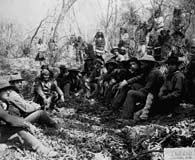 John Rose – Geronimo and Gen. Crook, Surrender Negotiations
John Rose – Geronimo and Gen. Crook, Surrender Negotiations
“The image I have in mind is not of an actual battle, but representative of a key part of the American success in dealing with the Apache. The photo is of Gen. Crook meeting with Geronimo and other Apache’s at Canon De Los Embudos, March 1886. Geronimo wanted this meeting after forces under Capt. Emmett Crawford successfully tracked and attacked Geronimo’s band two months earlier in January1886, in Mexico. Aided by his loyal Apache Scouts, Crawford had hounded Geronimo into submission, and it was Geronimo who sent messengers to Crawford saying he wished to surrender. Had it not been for the assassination of Capt. Crawford by Mexican forces the next day (January 11, 1886) there would be no C. S. Fly photos taken of Geronimo and Gen. Crook at Embudos. The meeting would never have taken place. Crawford would have taken Geronimo and company back to San Carlos and history would have been very different. 
What this photo illustrates is that in the case of a well armed native fighting force, whose tactics are based on broken landscape, remarkable endurance, and the willingness to run from a losing fight only to triumph with an ambush later on, hard strategy included eye to eye threats. Their will to fight had to be attacked with something more than bullets. Months later after Crook had left and Gen. Miles had assumed command, telling the hostiles that their families had been deported and seeing them meant surrender, worked. They no longer had the will to fight on. 

This and the other Fly photos taken at this place and time are widely believed to be the only photos of the American Indian hostile and free, not in chains or on a reservation.”
–John Rose
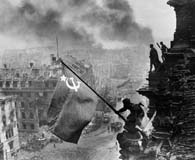 Barnet Schecter – Khaldei USSR Flag Raising Over Reichstag
Barnet Schecter – Khaldei USSR Flag Raising Over Reichstag
“My vote is for the photo of the Soviets planting their flag on the Reichstag in May 1945. It was the first photo that popped into my head as history’s greatest. It’s that famous and iconic for good reason. Visually, the bird’s eye view is intensely dramatic, placing the viewer alongside the conquerors at the summit, the great goal of their quest. Symbolically, the photo marks a sublime moment in human history — the defeat of Nazi Germany in 1945.
However, the photo is doubly important because it also signals the loss of Eastern Europe behind the Soviet Iron Curtain. The fact that the photo turns out to be staged, not the actual moment of conquest, makes it all the more brilliant as a work of art and propaganda, even as it reveals the habitual duplicity of the Soviet state.”
–Barnet Schecter
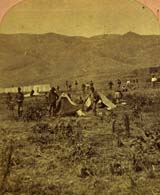 Doug Scott – Frontier Army on Nez Perce Campaign, 1877
Doug Scott – Frontier Army on Nez Perce Campaign, 1877
“My pick is from the Indian Wars. It is a stereograph of a group of soldiers setting up camp on the Clearwater River during the Nez Perce Campaign of 1877. The photograph depicts tents being set up in field conditions with men standing around, posing, as they were halted during their tasks by the photographer to make the exposure on a wetplate camera. The photograph was taken a few days after the battle of the Clearwater in Idaho where the army under Gen. O. O. Howard was essentially defeated by the Nez Perce led by Chief Joseph who managed to disengage and slip off. The 800 or so Nez Perce continued to elude the army for almost three months, fighting six pitched battles and several minor skirmishes in that period, losing only the last battle at Bear Paw in northeastern Montana. The image speaks to me of what field conditions were really like during the Indian Wars. It also conveys a sense of a somewhat demoralized field column as it chased the ever elusive Nez Perce across Washington, Idaho, Wyoming, and Montana during the summer of 1877. And it is an important image as it not only records the reality of 19th century field conditions, conveys the sense of the size of the countryside that the army had to search, but it also shows that photographic records of these events was not a novelty to the 19th century soldiers, yet it survives as a unique record of an army column in the field.”
–Doug Scott
 Hoyt S. Vandenberg, Jr. – P-47 wreck and pilot grave, WWII ETO
Hoyt S. Vandenberg, Jr. – P-47 wreck and pilot grave, WWII ETO
“I selected this picture for several reasons. It graphically depicts the wartime resting place of a P-47 pilot of the Ninth US Tactical Air force. The P-47 was the workhorse of the Ninth in its support of the 12th Army Group in Europe in WWII. By all accounts, the support provided by the ‘Jabos’ – the Germans’ nickname for the dreaded U. S. jadgbomber fighter-bombers — blazed a trail and covered the flanks of their brothers on the ground and was the allied weapon most feared by German soldiers. The grave and wreckage tell a tale of pathos and respect at the same time. Fifty-caliber cartridges and a cross represent this world and the next for this young pilot!”
–Gen. Sandy Vandenberg
 Caspar W. Weinberger, Jr. – Iwo Jima Flag Raising & Eisenstadt’s “VJ Day, Times Square”
Caspar W. Weinberger, Jr. – Iwo Jima Flag Raising & Eisenstadt’s “VJ Day, Times Square”
“Iwo Jima is the most memorable war photo in my mind because it shows so clearly the reason for war, its sweat and struggle, its bravery, its demand for a victory. The photo also came about when American photographic advertising was reaching its finest moments. Life and Look magazines would soon dominate the strong magazine markets. The visual reality was reaching a crescendo with the people. The idea of American patriotism as a great virtue was the campaign that was enhanced by this amazing photograph.
A close second would be Eisenstadt’s end of the WWII photo of the sailor and his girl embracing tango style in Times Square. In essence, the Iwo Jima photo represents the masculine side of war, while the peace embraced in the Eisenstadt photo is a clear picture of joy.”
–Cap Weinberger, Jr.
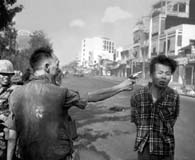 James H. Willbanks – Saigon Police Chief Executes VC, Tet 1968
James H. Willbanks – Saigon Police Chief Executes VC, Tet 1968
“My choice for one of the greatest war photos in history is that of Brig. Gen. Nguyen Ngoc Loan’s summary execution of the VC prisoner, Nguyen Van Lam, during the 1968 Tet Offensive. This photo was taken in Cholon on February during the battle for Saigon by Eddie Adams, a photojournalist for the Associated Press. Loan was the chief of the National Police. For many Americans, the photo of this incident clearly depicted the brutality of the war and added fuel to the antiwar movement, who saw the photo as proof that the war was immoral. Although Adams won the Pulitzer Prize for the photo, he was very conflicted about it for the rest of his life, believing that it only told part of the story and that it had thus been misinterpreted. Reportedly, Adams personally apologized to Loan and his family after the war for the irreparable damage that the photo had done to Loan’s reputation. Loan died of cancer at his home in Burke, Virginia, in 1998, and Eddie Adams passed away in September 2004.”
–James H. Willbanks, PhD


The marine at the Chosin reservoir name is corporal Robert Keith Henry. He was a Forward Observer in his beloved Marine corps. He is 81 years of age now and is still a Marine at heart and soul. He only spoke of his memories those 17 days of fighting a few times and only after a couple of beers. Those memories are gone now with the onset of alzhimers. I wanted thank you for choosing his photo, I know he was very proud of that photo being in life magazine as we were, his family. I am proud to say he is my Father. And I wanted everyone to know that marine name is Corporal R.K. Henry.
no it’s not.
Thank you. This is not his grandfather it is my husband’s. My husband joined the Marine corps. following in his grandpa’s foot steps, and saw his grandpa’s photo in the Marine Corps. museum!
No its not! How can you even say that? This is my grandfather in law Harry Partridge! What is wrong with you?
John Rose – Geronimo and Gen. Crook, Surrender Negotiations
“The image I have in mind is not of an actual battle, but representative of a key part of the American success in dealing with the Apache.
Maybe if settlers in America had not decimated Native American Indian culture and civilizations, continued to break treaty after treaty and invade their lands and obliterate their religions by forcing Christianity on them while giving them poor (reservation) land to live on, maybe “Americans would not have to *deal* with the Apache.” I find that line, the entire summary written above actually, entirely offensive. Maybe Geronimo should not have had to *deal* with the settlers and invading “Americans” to begin with.
This is my husband’s grandfather in the Chosin Reservoir photo.
Seems there is a lot of confusion as to the identity of the Marine in the Chosin Reservoir photo. I find this very interesting. One of my closest childhood friends had this photo displayed in her home. It is the spitting image of my friend’s father. Even he was very proud of that photo although he did not speak about it much. Those were not good memories. Anyway, his name was not either of the names listed above. I would be shocked if it was not him because it looks just like him. Either way, I am grateful to all the men who sacrificed so much for love of our country…even those who were not in Life Magazine. Merry Christmas!